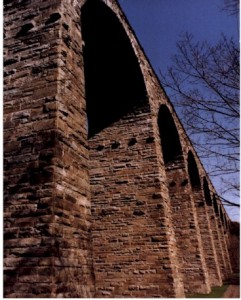Bridges to the Future
Bridges to the Future
Built nearly a century apart, both the Starrucca Viaduct and the Martin’s Creek Viaduct in Susquehanna County, Pennsylvania stand as brilliant markers in the civil engineering history and as bridges to the future of the railroad industry in Northeastern Pennsylvania.
In 1847 the clock was running for project engineers in charge of design and construction of a section of the New York and Erie Railroad between the Hudson River Valley and Lake Erie. The railroad had to reach Binghamton, NY by December 31, 1848 and a quarter mile wide valley outside of Lanesboro, Susquehanna County, Pennsylvania had to be crossed. To do so, civil engineers Julius Adams and James Kirkwood designed and built the Starrucca Viaduct, a 1,040 foot structure comprised of 17 arches averaging 100 feet in height. The viaduct was constructed of Pennsylvania Bluestone, a local dimension stone quarried nearby. With a price estimated at $325,000, the bridge was one of the largest, costliest stone arch railroad bridges built in America. Yet the very material that made it so costly to build, has given the Starrucca Viaduct durability. When contemporary wooden railroad bridges failed to stand up under modern, heavier loads, the stone frame of the Starrucca Viaduct has stood the test of time. The bridge’s designers also made the deck wide enough to accommodate two tracks by today’s standards. Both Norfolk Southern and New York, Susquehanna and Western freight trains still rumble across this designated Landmark of Civil Engineering, through the Tri-Boro area of Susquehanna Depot, Lanesboro, and Oakland, passing a former locomotive refueling station, which is now a 36 acre designated Keystone Opportunity Zone property, poised for development as an industrial or inter-modal facility.
Further southeast in Harford Township outside the village of Kingsley, construction on the Martin’s Creek Viaduct began in 1912 and was completed in the Fall of 1914, a year ahead of schedule. The construction of the viaduct was part of a modernization of the Delaware, Lackawanna, and Western line from Clark Summit to Hallstead. Known as the Clarks Summit-Hallstead Cut-off, the 39.6 mile project shorted the distance between Clarks Summit and Hallstead by 3.6 miles, reduced the grade and produced a remarkably straight route that would save a freight train as much as an hour and a passenger train at least ten minutes. It cost the railroad 12 million dollars to complete.
“The project was built with very advanced standards for its time – and it’s still a first class piece of railroad. The real improvement was in the grades and curves,” comments railroad historian William S. Young, who is writing a book on the construction of the Lackawanna Cutoff. “At the time, Portland cement was a new material; and reinforced concrete a newer concept.” Young adds that the use of the reinforced concrete arch in railroad bridge construction began about 1900 and ended by 1930 when engineering advances ushered in new techniques. “Concrete is being used today in different ways – for example, pre-cast, pre-stressed girders are being used on a new highway bridge under construction between Hallstead and Great Bend over the Susquehanna River.”
The Martin’s Creek Viaduct is 1600 feet long and has 150 foot high arches and is often mistaken for the much larger Tunkhannock Creek Viaduct, which is located about nine miles south of Martin’s Creek along Route 11 in Wyoming County. The Tunkhannock Creek viaduct was part of the same railroad improvement project and at 2,375 feet long with 240’ high arches, it is considered the largest concrete structure of its kind in the world.
Soldiers guarded the Martin’s Creek Viaduct during World War I. Trains stopped at the nearby Kingsley station and further north on the line in New Milford and at a newly constructed station in Hallstead, which is now Station Square, a commercial business property available for lease. The viaduct was an important part of the “Route of Phoebe Snow”, the famous “Maid in White” advertising campaign of the Delaware, Lackawanna and Western Railroad from 1900 to 1960. Phoebe Snow advertisements declared she could travel the entire line from Hoboken to Buffalo and arrive with her white dress pristine because prior to the diesel age the railroad’s passenger engines used only clean burning anthracite coal. With the advent of diesel after World War II, a passenger train bearing the name “Phoebe Snow” was introduced. “That train was removed in 1966,” recalls William Young.
Today the return of passenger service to New York and New Jersey environs is under development in nearby Scranton, Lackawanna County, PA. Studies that examine expanding the service through Susquehanna County, PA north to Binghamton, NY are also underway.
Both the Starrucca and Martin’s Creek Viaduct are easily accessible to visitors traveling on Interstate 81. The Starrucca Viaduct is located about 10 miles from exit I-81 exit 230 (Great Bend, PA) on SR 171 in Lanesboro, Susquehanna County. The Martin’s Creek Viaduct is located south of Kingsley PA off Route 11. Take SR 106 west at the I-81, Exit 211(Lenox, PA) to reach Route 11.
Starrucca: Bridge of Stone by William S. Young is available from the Susquehanna County Historical Society for $5.00 plus tax and shipping. Visit their website, www.susqcohistsoc.org. or telephone (570) 278-1881 for more information.

